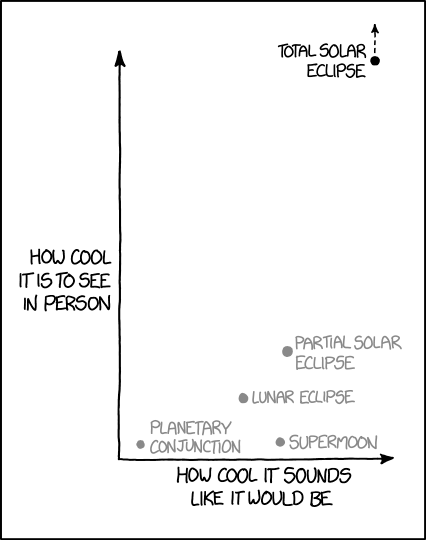You may have noticed a lot of people in a certain region of the North American continent freaking out this past week about something other than the state of the region’s political climate.

The internet being, well, the internet, a lot of people suggested we downplay our excitement. This included not only folks who wouldn’t be anywhere near the path of totality, but mister Dr. Neil deGrasse Tyson himself (I suppose he’s known for being a party pooper on Twitter, so maybe this shouldn’t be surprising).

Of course it’s natural for people who don’t have a background in astronomy to not know how often certain astronomical events are. I can’t even begin to estimate how many Americans could have told you how often, on average, there’s a total solar eclipse anywhere on the planet (It’s at least 2).
But for the average human being, these events are rare. Who on Earth other than millionaires and eclipse chasers – people who spend basically what amounts to all their money going to see every eclipse they possibly can – are going to see more than one total solar eclipse (maybe two) in their lifetime? Even among those in the country that would have otherwise loved to, so many people this year didn’t get to see totality – e.g. because they couldn’t take work/school off, or ended up traveling to a place that ended up having lousy weather (i.e. my next-door neighbors).
‘Rare’ is relative. The last time the continental US saw a total solar eclipse, it was 1979. That was 38 years ago. Over 100 million people have been born in the country since then – (very) roughly a third of the entire current population; that includes yours truly. The next one that touches American soil is in 2024. For how many people will that one be their first opportunity to witness that amazing corona? Not just see the Pac-Man-esque orange disc – that is, a partial solar eclipse through a filter. Not just see the sky get dark and maybe hear some animals nearby freak out because there is there at least one improperly-placed cloud in the sky.


All those photos you see of the event do not do the actual phenomenon justice. From where I stood, in a backyard in Kearney, Nebraska, the sky was an unforgettable shade of – I’m not sure how to describe it – dark periwinkle? A blend of blue and purple I don’t remember ever seeing before in nature. You could see the dark side of the Moon, all patches of deep grey, nestled in that brilliant white wreath of white plasma which extended much further into the sky than you can see in the image above. No photograph, no matter the skill of the photographer, will ever resemble what I saw that day.

I might never see it again. I wish every single person on the planet could have the opportunity to see this literally awe-some astronomical event.
I wonder how many of these wet blanket-throwers know how much a cosmic fluke it is that we even have the opportunity to witness a total solar eclipse in the first place. Given the size of the Sun in the sky, the Moon is just the right size and distance away from the Earth that this alignment can happen. [Note: There is a little wiggle room, but because the Moon’s orbit is slowly receding (due to angular momentum) in ~600 million years Earth will never have another total solar eclipse.]
I know you know, Neil.
You can teach people how often solar eclipses happen without trying to bum people out, Neil.
